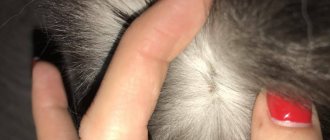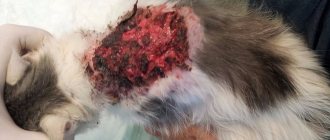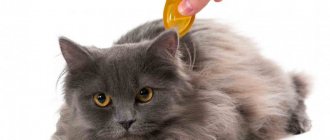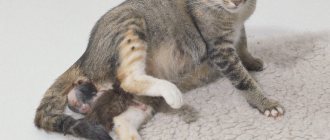Even if your furry pet has never left the apartment, this is not considered a guarantee that the cat cannot develop fleas. They are carriers of dangerous diseases for both humans and animals. The size of an adult individual is on average 3 mm, the body is flattened laterally, which gives it the opportunity to move along the coat without problems. In addition, they are incredibly bouncy and invisible to the human eye. These sneaky, tenacious creatures will be discussed.
How can you tell if a cat has fleas?
These parasites are capable of multiplying at lightning speed. Therefore, their presence can be determined by the following manifestations:
- Severe, frequent itching. The pet is constantly itching and acting restless. The larger the colony, the more severe the itching.
- Deterioration of coat condition. It becomes dimmer. Bald patches may appear as a result of hair loss.
- Small wounds and scratches can be found on the body. When infection attaches to the wound surface, abscesses and fistulas may develop.
- When there is a large accumulation, they are clearly visible on the pet’s face and neck.
You can also determine their presence if you stand the cat on a white sheet of paper while brushing. Small black dots will be visible on the paper sheet. This is flea dirt or their feces. To be sure, pour a little water on them and they will turn red or brown.
Sometimes you can see small whitish dots, these are flea eggs.
Flea
Consequences of allergies
Severe itching of the skin, which occurs in response to flea saliva, causes the cat to actively itch and bite the skin with its teeth. This leads to mechanical damage to the epidermis and the appearance of open wounds. As a result, a favorable environment for secondary infection is created. Infection aggravates the course of the allergy and can lead to the formation of large inflammatory areas in which pus accumulates.
The resulting wounds contain pathogenic fungi and bacteria, which are not at all easy to deal with.
Allergies also have an extremely negative effect on the animal’s immune system. Suppressed immunity reduces the body's resistance to various viruses and infections. The cat's general condition and behavior are only getting worse.
In addition, allergies can trigger the development of Quincke's edema. This is a complex pathological condition that can lead to the death of an animal due to suffocation.
How to treat bites
If a secondary infection develops at the bite site or an allergic reaction develops, you should contact a veterinarian. It is the specialist who will help you choose the most effective drugs for treating the wound surface. If it is not possible to show your pet immediately, then you can apply a solution of brilliant green or iodine to the wound.
Treatment for parasites
How to eliminate an allergic reaction
If a cat has an allergy to flea bites, then treatment begins with eliminating the factors that provoked it. When the first signs of a reaction to dermatitis appear, the cat is given an antihistamine, the dosage of which is selected by the doctor.
- Suprastin.
- Diphenhydramine.
- Tavegil.
Tavegil
When an allergic reaction develops, treatment is indicated with the use of hormonal agents.
- Prednisolone.
- Dexafort.
- Dexamethasone.
To exclude subsequent infection and inflammation in the area of the bite and cat scratching, they are treated with chloramphenicol ointment. Also, if you are bitten by a flea, use creams that contain aluminum.
- Aluminum.
- Alusprey.
When treating an animal with a bite allergy, make sure that it does not lick the applied products. To do this, the cat wears a special bell collar.
In severe cases, corticosteroid injections are prescribed to eliminate symptoms and prevent outbreaks of pathology. If there is a secondary infection, a course of antifungal agents or antibiotics is required.
Immunotherapy is also a modern method in the fight against allergies. Over a long period of time, the cat is administered an extract of flea saliva, which makes it possible to develop the necessary immunity against antigens. As a result, in most animals, allergies disappear completely or occur in rare cases.
immunotherapy
Products for removing fleas from domestic cats at home
Let's look at the most popular flea remedies.
Celandine
Shampoo
A harmless means of eliminating ectoparasites. As a rule, the action is aimed at adult fleas without affecting flea eggs. Most often used: Bars, Rolf Club, Mister Keys.
They help get rid of fleas, but do not protect against re-occurrence.
Drops
They have a detrimental effect not only on adults, but also on parasite eggs. By applying the drops once, you will protect your pet from infection for 1-2 months. The most popular: Bars from 10 months, Stronghold, Hearts from 3 months, but not during pregnancy and for lactating animals. Advantage from 2 months of age.
Collars
Their effect lasts from 2 to 7 months. Recommended for pets walking outside. Most often used: Bars, Hearts, Beafar.
Spray
The most effective sprays were shown: Bars, Hearts, Frontline. It is advisable to treat your pet with them outside. 30 minutes after application, rinse off the spray with running water and comb your pet. At the same time, the animal's bed should be treated.
Applying flea spray
Where do lice come from and how to deal with them
2018-09-15 City Disinfection Station
Pediculosis is a fairly common disease that is caused by small blood-sucking insects - lice. Most often you have to deal with head lice, which find refuge in human hair and become the cause of lice or, what is much more dangerous, typhus, since they are its carriers. Despite the fact that the standard of living of people is constantly increasing, according to world statistics, the percentage of infection with this disease, even in developed European countries, is not decreasing.
What is a head louse?
A louse is a small blood-sucking insect that cannot fly or jump, but thanks to the structural features of its clawed legs, it moves easily and nimbly in human hair. It prefers to inhabit mainly the occipital, parietal and temporal zones of the head, but as populations increase, they occupy the entire area. This small, elongated parasite has a body 2–3 mm long, light gray in color, which changes to brownish-brown when saturated with blood, and can also masquerade as hair color.
Insects are highly fertile; one adult female lays 10 eggs daily - nits, which after 12 days turn into a full-fledged insect and the cycle repeats again. During her life (28–30 days), an adult female manages to lay up to three hundred nits, firmly attaching them to her hair with a special adhesive substance that is not affected by detergents and frequent combing. Therefore, if serious measures are not taken to combat them, the population will grow exponentially.
Methods and symptoms of infection
You can only become infected with this unpleasant disease through contact from another person. This can happen while traveling in public transport, especially crowded ones, and can be transmitted through clothing, underwear, and combs. Most often, head lice occurs in children of preschool and school age, regardless of the well-being of the family and their attitude to hygiene, since children's games contribute to very close communication.
It is quite difficult to quickly determine the appearance of lice, since due to their size and agility they are difficult to see with the naked eye. But a number of signs may indicate their presence:
- A person is bothered by severe and frequent itching of the skin under the hair.
- New red dots or small pustules constantly appear.
- A rash may appear under the hair on your neck.
- Lice can cause swollen lymph nodes.
- You can find small shiny light-colored or hair-colored hard balls firmly attached to the hair.
If at least one of these signs occurs, you should immediately examine your hair, preferably with a magnifying glass. If a louse is found, it is necessary to begin treatment immediately, since delay threatens the complete occupation of your hair by parasites. However, if you are unsure, visit a doctor.
How to identify lice
If you suspect that your child has lice, you should sit him in a well-lit place and carefully examine his head over a table covered with a white cloth or paper. It is very difficult to notice adult individuals, since they are very active and quickly hide from the light, but you can see their eggs, which in the form of oval shiny light balls are firmly held on the hair near the root. In order not to confuse them with dandruff and debris, try to shake them off; this is impossible to do with nits; they are even difficult to remove with your hands. Wet your child's hair and begin combing the hair with a special fine-tooth comb.
How to cure pediculosis?
If lice are found, contact your pediatrician, who will recommend an effective and reliable remedy. Today, pharmacology offers many chemical agents to combat lice; they are available in different types and consistencies. These can be lotions, shampoos, sprays with different percentages of toxins, and therefore effectiveness. Therefore, choosing the safest means is not always rational, since treatment will require a very long time and a large number of treatments.
The effectiveness of treatment depends on the correctness of its implementation. The selected product is applied to the hair strand by strand from the roots and along the entire length of the hair and left for a certain time, it is indicated in the instructions for use. In order not to harm the child, it is not worth increasing this time due to toxicity. Then the product is washed off and dead insects are combed out of wet hair. If after the procedure you find a live louse, it means that somewhere the process was disrupted or the product was ineffective.
It must be said that it will never be possible to get rid of unpleasant inhabitants in one treatment, no matter how effective the drugs are, since they kill only adult individuals, while the nits remain alive and unharmed. They are protected from the effects of many chemicals by a durable chitinous shell, so you can only get rid of them by combing them out. To ensure that nits come off the hair easily when combing out, it is recommended to moisten the hair with a vinegar solution (1 part vinegar 9% diluted with 2 parts water). The acid softens the adhesive that attaches the eggs, and they easily fall away under the comb.
Therefore, hair treatment will have to be carried out several times every 7 - 10 days, usually 2 - 3 times are enough. The main thing is to have time to destroy the newly hatched individuals before they reach sexual maturity. If lice are found in one family member, then everyone needs to be checked and a one-time treatment is carried out for prevention.
How to prevent lice
It is simply impossible to protect yourself and your children 100% from the appearance of lice, but minimizing this is quite possible. To avoid infection, you should not use other people's personal belongings, such as combs, towels, and hats. Also visit untrustworthy hairdressing salons and spa salons, periodically check the hair of all family members, especially children after holidays in camps and at the beginning of the school year.
Author of the material: Vladimir Egorov
Disinfector Experience in the field for more than 4 years
Flea medications for cats
The most commonly used tablets, powders or injections are:
- Pills. The principle of operation is simple: the active substance penetrates the pet’s blood and, when bitten by a parasite, poisons it, which leads to death. Medicines based on the hormone lufenuron are mainly used. They have virtually no side effects and are safe for animals and humans. However, they do not eliminate the itching problem.
- Injections. They are done subcutaneously from 10-12 months, but are not suitable during pregnancy and for sick cats. Most often used: Ivermek, Cantaren, Microderm.
- Powders. The entire coat is treated against hair growth by rubbing. The remaining powder must be combed out. Most often, the active substance in them is propoxur. The drug Zecken Und Flohpuder is often prescribed.
Features of facial skin infections
The blood supply to the organs of the head, face, and membranes of the brain is closely connected. Incorrect treatment and squeezing of pimples is dangerous due to the spread of bacteria through the blood and lymph. You can achieve an increase in the area of the affected area, such dangerous complications as meningitis, abscesses and phlegmon, and inflammation of the eyes.
Before deciding on cosmetic procedures - cleansing, peeling, mesotherapy - undergo an examination by a dermatologist to determine the cause of the pustular rash and receive treatment.
Why are fleas dangerous?
There are a number of other factors why it is necessary to destroy parasites:
- infection with helminthic infestation (develops quite often);
- are distributors of fungal infectious diseases (usually plague);
- complete baldness of the pet (the coat is not restored, even after recovery);
- mental disorder in a cat.
Bites
Change in animal behavior
In addition to visual manifestations on the skin and hair loss, the psycho-emotional state of the animal changes. Due to severe, incessant itching due to an allergic reaction, the cat’s appetite decreases or completely disappears. The pet does not walk, becomes passive, spends most of its time lying down, scratching its skin.
Some cats, instead of passivity and apathy, on the contrary, may behave differently: their irritability increases, excessive aggressiveness occurs, which increases even more when the owner tries to touch damaged areas of the skin. The reaction to stroking the fur is a pitiful, prolonged meow.
Prevention
- treating your pet with anti-flea agents, wearing a collar;
- extermination of parasites in the house and surrounding area.
In addition to treating the animal itself, pay attention to treating the apartment:
- Vacuum the room regularly, paying attention to hard-to-reach places (corners, baseboards, space under furniture);
- in parallel, use anti-flea agents to treat premises, for example, methoprene or pyriproxyfen;
You can also prevent the disease by observing the following rules:
- avoid contact with street cats;
- regularly treat household items (bedding, toilet, houses, beds) with boiling water;
Scratching bite sites
Superficial bacterial skin infections
Folliculitis
- inflammation of the hair follicle: abscess around the hair, redness of the surrounding area.
Pemphigus of newborns
- a severe contagious disease when inflammatory blisters cover the baby’s entire body, forming crusts and ulcers.
Impetigo
- against the background of redness, painless blisters with cloudy contents appear. Then the blisters shrink to yellowish crusts, leaving erosions.
Impetigo often occurs in children and young women. Localization: face, under the hair of the head, limbs. When staphylococcus attaches, the crusts become greenish or bloody. The disease spreads quickly in communities. If you suspect it, you need to isolate the child and bandage the wound.
Danger to humans and whether they are transmitted
Cat fleas do not live on the human body, but the safest damage that can be caused by a bite is bright spots from very painful bites and scratch marks. With constant scratching, the risk of secondary infection increases. And this is fraught with inflammation and suppuration of the skin.
However, this is not the worst thing. What’s much worse is that a bite can lead to infection with the following diseases:
- anthrax;
- typhus;
- plague;
- encephalitis;
- hepatitis;
- helminthiases.
Diagnosis of the appearance of dermatitis
The owner can independently determine the presence of fleas in a pet by changing behavior and examining its fur. But only a veterinarian can make an accurate diagnosis - an allergy to parasites - based on the results of laboratory tests and examination of the animal. To clarify the primary diagnosis, a sample is taken from the affected area of the skin and examined. In addition, an allergen test is prescribed.
Allergic dermatitis as a negative reaction to a large number of fleas has similar symptoms to a number of other diseases. Therefore, differential diagnosis is required. Allergy to parasites must be distinguished from diseases such as lice, sarcoptic mange, alopecia, and pemphigus foliaceus.
Dermatitis is a skin reaction that is a symptom and not a disease itself.
How do fleas reproduce in cats?
During its life cycle, a blood-sucking insect is capable of laying more than 400 eggs. To procreate, she needs to eat. They bite through the skin of the animal and drink its blood. In one clutch, the female can lay up to 8 white eggs. The development of larvae does not occur on the skin of cats, but on any objects in the living room, that is, wherever they fall from the fur.
The larvae feed on rudiments and feces of adult insects. After 1.5 months, an adult insect emerges from the egg.
Fleas on cats cause harm not only to the pet itself, but also cause problems for breeders. Today, no remedy has yet been developed that would permanently rid animals of blood-sucking parasites. Therefore, it is better to prevent a disease than to treat it. And in case of infection, it is better to contact a veterinarian to prescribe effective treatment.
Cat fleas: morphology and development cycle
The cat flea is one of the parasites of animals that can also attack humans. She looks like a tiny dark insect without wings. Body size: 0.5–5 millimeters. However, a female engorged with blood can swell up to 16 millimeters.
Fleas parasitize cats and rats. When attacking a person, it selects the area of the legs below the knee.
The lifespan of a flea depends on living conditions and usually ranges from 3 months to 1.5 years.
Favorable conditions for fleas
| Temperature | 20–25 ºС |
| Air humidity | 60 % |
| Humidity | 70 % |
Fleas breed all year round. One female is capable of laying from 2 to 15 eggs at a time. Thus, an individual can reproduce about 500 throughout its life.
Important! This number is arbitrary, since for the eggs to fully mature, the female needs to fully feed on blood.
Places for laying can be different: cracks in the floor or walls, bedspreads or animal beds, food waste, soil, pet hair.
Stages of flea development:
- Egg. A tiny white dot. Size: 0.5 millimeters. Cycle: from 2 days to 2 weeks.
- Larva. Resembles a worm with segmented hairs. Size: about 5 millimeters. It is mobile, growing by eating feces, blood or plant waste. Cycle: from 9 days to 8 months.
- Doll. Looks like a larva in a cocoon. Cycle: from 6 days to 1 year.
- Imago. Is a full-fledged adult.











